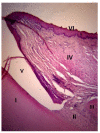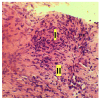A New Way to Model Periodontitis in Laboratory Animals
- PMID: 37754339
- PMCID: PMC10527576
- DOI: 10.3390/dj11090219
A New Way to Model Periodontitis in Laboratory Animals
Abstract
The prevalence of periodontal diseases is increasing, tends to increase with age and is considered as one of the main causes of tooth loss. To assess the effectiveness of new methods of treatment of periodontal diseases, studies on laboratory animals can be promising.
The aim of the study: to develop a new method of accelerated modeling of experimental periodontitis on laboratory animals.
Material and methods: The study was carried out on 22 female rats. A wire ligature was applied to the cervical area of the incisors of the animals in an eight-shaped manner. Plaque obtained from a patient with periodontitis was placed under the wire, and nicotine and ethyl alcohol solutions were injected under the gingival mucosa. A complex index has been proposed to assess inflammation. At the end of the experiment the animals were euthanized, their jaws were dissected into dentoalveolar blocks and further descriptive histologic analysis was performed.
Results: On the second day the gingiva of the rats acquired a cyanotic-pink color, on the fourth day the consistency of the gingiva became friable, mobility appeared in the lower incisors. Complex index of inflammation in animals of the main group: before the study-9, on the 7th day-195. Gingival preparations showed signs of exudative inflammation. In alveolar processes-irreversible resorption of bone structures. The difference of indicators in animals before and after the experiment was statistically significant (p < 0.05).
Conclusion: The new experimental model of periodontitis is reproduced in a short period of time, provides intensive development of inflammation, leads to disruption of the integrity of epithelial and connective tissue attachment, destruction of alveolar bone.
Keywords: animal model; experimental induced periodontitis; histologic analysis; inflammation.
Conflict of interest statement
The authors declare no conflict of interest. The sponsors had no role in the design, execution, interpretation, or writing of the study.
Figures







References
-
- Unanyan K.G., Balmasova I.P., Tsarev V.N., Mkrtumyan A.M., Elbekyan K.S., Karakov K.G., Gontarenko M.S., Arutyunov S.D. Lipid metabolism as microecological and systemic factor in the development of periodontal disease: A review. Clin. Dent. 2020;3:36–43. doi: 10.37988/1811-153X_2020_3_36. (In Russian) - DOI
LinkOut - more resources
Full Text Sources
Medical
Research Materials

